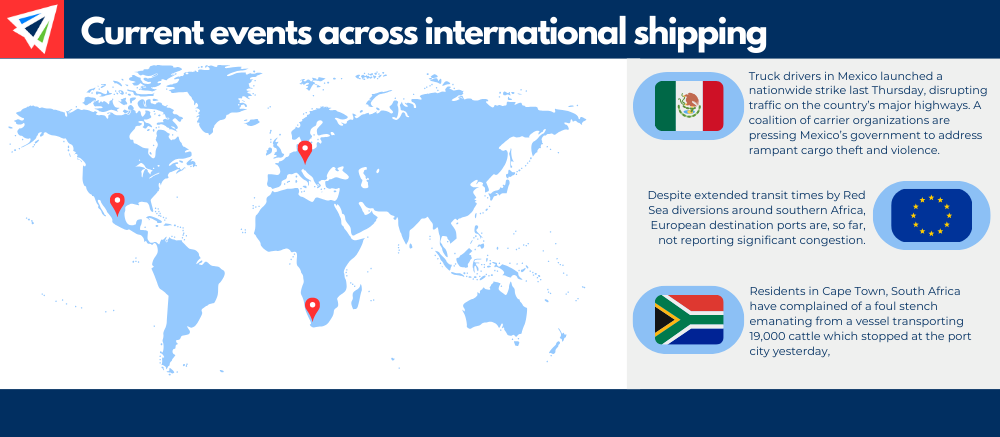
IMPORT: Asia to North America (TPEB)
Recent Developments:
- [Port of Houston] Courtesy of an email notice from Maersk, the Gulf Coast port has announced plans for implementing two “Dwell Fees” as it looks to relieve longstanding imports at container terminals.
- The two fees are the “Sustained Import Dwell Fee” and the “Excessive Import Dwell Fee”. Both charges are the responsibility of the cargo owner with the port not granting any exceptions. Contact us for more information.
- Pre-Lunar New Year bookings for Chinese imports were well above last year’s levels, according to an index from FreightWaves SONAR.
Rates: Rates remain elevated and disproportionately higher on containers bound to the East Coast.
Space: Space is mostly open but has seen some tightening.
Capacity: Longer transit times around southern Africa (to avoid the Red Sea) are absorbing vessel capacity. However, carriers remain well-supplied with available vessels to manage the adjustment.
TIPS:
- Hold your logistics partners accountable for frequent updates regarding current market conditions and routing impacts.
- Be flexible and adaptive to alternative service options, especially as it relates to potential savings on cost or transit.
IMPORT: Europe to North America (TAWB)
Recent Developments:
- Europe’s three largest container ports—Rotterdam, Antwerp, and Hamburg—have all reported sharp declines in volume for 2023. Their performances reflect a broader theme of economic anemia looming over Europe.
Rates: Rates have risen since the start of the month, but given the ongoing spell of dormant demand, this increase will likely be reeled in.
Space: Space is open.
Capacity: Capacity remains abundant. Carriers are partially curbing this by reducing the size of vessels operating on transatlantic lanes. Though, significant blank sailing programs have not been implemented.
Equipment: Availability on both origin and destination sides, unless advised otherwise.
TIPS:
- Book at least three weeks prior to the ready date.
- Communicate with your logistics partners to ensure that you’re up to speed on the EU ETS program and its evolving impacts on transatlantic trade.
- Keep an eye on carrier discretion when it comes to their managing of the market. While this trade favors shippers at the moment, carriers could become more aggressive with tactics, like rate increases or blank sailings, to prevent further lossmaking.
EXPORT: North America to Asia
Rates: Rates have risen in mid-February.
Capacity: Space remains open, particularly from West Coast ports, however carriers remain curbing capacity via blank sailings and slow steaming as U.S. import demand remains challenged.
Equipment: Barge services in China are temporarily suspended for the LNY holiday period.
TIPS:
- Insufficient communication with sailing schedules can lead to higher detention and demurrage fees as well as higher trucking and storage costs. Ensure your logistics partners are not keeping you and your cargo in the dark.